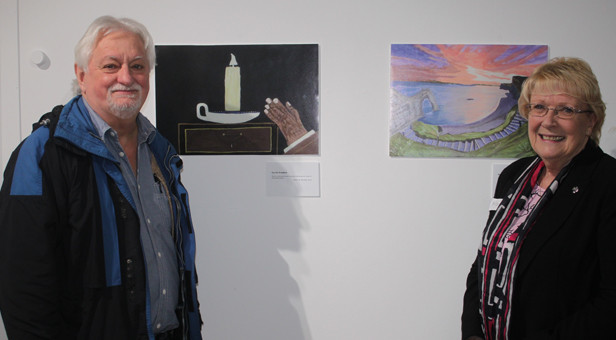
Stroke survivors were given the opportunity to view their artwork at the launch of a unique exhibition at Bournemouth University.
The artwork is the result of a study called ‘HeART of Stroke’ in which stroke survivors were invited to a series of workshops to explore new ways of seeing the world and their identity. The exhibition includes an array of collages, paintings, object installations and an interactive activities table for visitors to have a taste of what the workshops were like.
The study was led by BU in partnership with the Royal Bournemouth and Christchurch Hospitals NHS Foundation Trust (RBCH). The study formed part of a larger investigation that included Cambridgeshire Community Services and explored whether creative expression could improve the confidence and wellbeing of stroke survivors.
Funded by the National Institute for Health Research (NIHR) Research for Patient Benefit (RfPB) Programme, the project was a feasibility study designed to lay the foundations of a larger scale research trial in future.
The research study, coordinated by BU Research Assistant Mary Grant, saw the random allocation of 16 people who had previously received treatment in the Stroke Unit at the Royal Bournemouth Hospital (RBH) to either attend the HeART of Stroke workshops alongside their usual care or continue to receive their usual care only.
Participants who attended the HeART of stroke workshops were invited to create art pieces from a range of materials as a way of exploring their new situation.
More than 40 people attended the launch, including many of the participants who took part in the study. 75-year-old Marjorie Legg of Bradford Road in Throop attended the workshops after experiencing a stroke in October 2013, she said: “I had a stroke not long after my husband passed away. I had faultless treatment on the Stroke Unit at the Royal Bournemouth Hospital, but my mood continued to be very low. The stroke had stripped me of all my confidence, I didn’t want to go out and do anything.
“I was a bit nervous about taking part in the workshops at first – I’d never been arty or drawn anything before in my life, but the workshops were fantastic and really built up my confidence. I now go on coach trips to see new places and have even enrolled in an evening art class. The study has shown me there is life after stroke.”
Martin de Berckem Dunn who also took part, said the study encouraged his brain to work when it felt “closed down”. He said: “I always liked to get out and do things, I feel like the sessions have brought me back – I’ve found myself again”.
Speaking at the launch, Dr. Caroline Ellis-Hill, Senior BU Lecturer in Qualitative Research, said: ““so much of stroke care and research focuses on the physical, but peoples’ sense of self is absolutely vital to their recovery and well-being.”
She went on to praise colleague and facilitating artist Dr Catherine Lamont-Robinson, saying: “Catherine is highly skilled and has an incredible grounding in ‘Arts for Health work’. Her contribution to the study has been invaluable.”
The team now hopes the study will form the basis of a wider project in the near future, gathering more evidence for the use of art as a positive form of rehabilitation for people following a stroke. Dr Sarah Thomas, a senior researcher at Bournemouth University Clinical Research Unit, said: “Findings from the feasibility study are promising and suggest a larger study is warranted. Interviews with participants show that many of them found the HeART of Stroke workshops helpful.”
The free HeART of Stroke exhibition is open to the public from 9am-6pm until Friday 29 January at the Atrium Art Gallery on Bournemouth University’s Talbot Campus.






